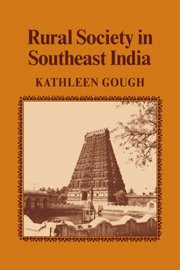Book contents
- Frontmatter
- Contents
- Preface
- Part I Thanjāvūr
- 1 The District
- 2 Castes and Religious Groups
- 3 The Agriculturalists
- 4 The Nonagriculturalists
- 5 Variations in Ecology, Demography, and Social Structure
- 6 The Colonial Background and the Sources of Poverty
- 7 Political Parties
- Part II Kumbapeṭṭai
- Part III Kirippūr
- Notes
- Glossary
- Bibliography
- Index
- CAMBRIDGE STUDIES IN SOCIAL ANTHROPOLOGY
6 - The Colonial Background and the Sources of Poverty
from Part I - Thanjāvūr
Published online by Cambridge University Press: 29 October 2009
- Frontmatter
- Contents
- Preface
- Part I Thanjāvūr
- 1 The District
- 2 Castes and Religious Groups
- 3 The Agriculturalists
- 4 The Nonagriculturalists
- 5 Variations in Ecology, Demography, and Social Structure
- 6 The Colonial Background and the Sources of Poverty
- 7 Political Parties
- Part II Kumbapeṭṭai
- Part III Kirippūr
- Notes
- Glossary
- Bibliography
- Index
- CAMBRIDGE STUDIES IN SOCIAL ANTHROPOLOGY
Summary
In 1951, the cultivating tenants and agricultural laborers in Thanjāvūr, as in India generally, lived in direst poverty, while the small holders and artisans were little better off. This poverty was not endemic to Thanjāvūr, but resulted from two centuries of colonial exploitation and distortion of the economy. In this chapter 1 will trace the growth and entrenchment of poverty in Thanjāvūr up to 1951–3, and in so doing describe the changing class structure of the region. To understand Thanjāvūr's poverty we must go back at least to the 1770s, when the British effected a de facto conquest of the district. Before probing the changes of the colonial period, however, I shall first sketch the pre-British social system.
Chōla Society
The Chōla kingdom of about 850–1290 A.D. appears to have been a complex variant of what Marx called the “Asiatic mode of production.” This type of state has more recently been described by Darcy Ribeiro as a “theocratic irrigation state,” and by Samir Amin as a “tributary system” combined with “patriarchal slavery.”
Thanjāvūr in this period formed the heartland of a major kingdom, drawing booty and captured slaves from other regions. Its economy rested mainly on the government's maintenance of irrigation works, which made possible the intensive cultivation of wet rice, the staple crop. The major dams began to be constructed as early as the first century A.D., but irrigation was greatly expanded in the ninth to twelfth centuries.
- Type
- Chapter
- Information
- Rural Society in Southeast India , pp. 105 - 137Publisher: Cambridge University PressPrint publication year: 1982



